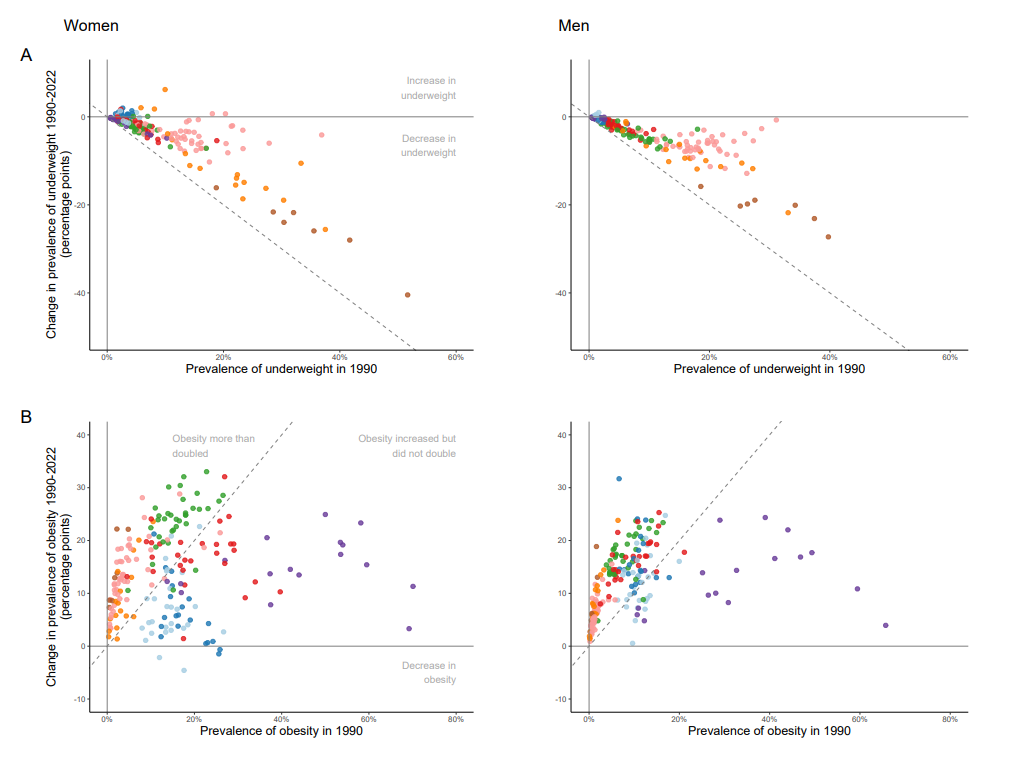
The combined burden of underweight and obesity has risen in most countries
In 2022, over a billion people globally were living with obesity with 160 million of them aged 5-19.
A study published in The Lancet used data from 3663 population-based studies that measured the height and weight in representative samples of the general population between 1990 and 2022. There were 222 million participants spanning all age groups and covering 200 countries and territories.
They found that over that timescale the combined burden of underweight and obesity had increased in most countries driven by an increase in obesity. Whilst the proportion of adults classed as underweight had fallen by 50%, it still remains a real problem, particularly in poorer communities in south Asia and parts of Africa.

There are significant health risks with being obese. In addition to cardiovascular disease which we have already mentioned, there are also links to type 2 diabetes, cancer, dementia, psychological distress and infertility.
Significantly the problem is on the rise in low- and middle-income countries, particularly in towns and cities. This can be exacerbated as these countries may not have the same access to healthcare.
The authors of The Lancet study called for a "healthy nutrition transition that enhances access to nutritious foods... to address the remaining burden of underweight while curbing and reversing the increase in obesity."
One nutritional 'villain' is ultra-processed foods (UPFs). Across high income countries, the share of dietary energy derived from UPFs ranges from 10% in Italy to 58% in the United States. In low and middle income countries, it can still be material from 16% in COlombia to 30% in Mexico, for example.
A recent meta-analysis published in the BMJ found that consumption of UPFs were directly linked to 32 harmful health conditions including the health risks linked to obesity mentioned above.
We have previously written about the food industry itself starting to get onboard with the need to improve the healthiness of foods to reduce and ultimately reverse incidents of obesity and the associated diseases and conditions. As consumer attitudes change, the shift from the old world dominated by convenience to a new more sustainably and healthy conscious market could happen faster than expected meaning that those food and beverage companies that are not ready will be competitively disadvantaged.
You can read that blog here which also includes some words of caution about BMI as a measure of obesity and that not all UPFs are the same. It is really the High Fat, High Sugar, High Salt (HFSS) foods that are most worrisome 👉🏾 https://www.thesustainableinvestor.org.uk/perspective-processed-foods-cost-advantage-competitive-disadvantage/
This article featured in What Caught Our Eye, a weekly email featuring stories we found particularly interesting during the week and why. We also give our lateral thought on each one. What Caught our Eye is available to read in full by members.
If you are not a member yet, you can read What Caught Our Eye when it comes out direct in your email inbox plus all of our blogs in full...

Click this link to register 👉🏾 https://www.thesustainableinvestor.org.uk/register/

Please read: important legal stuff.

